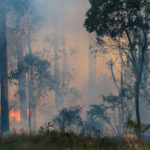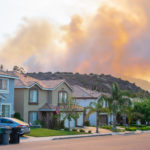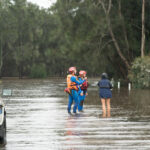The Correlation Between Hot Weather and Increased Crime: A Concerning Trend

Hurricane Milton has officially touched down in Florida in the United States, leaving more than 3 million residents without power – and thousands lost, injured, and even presumed dead.
Along with the real-time effects of the intense weather event that has rocked North America, residents must face another concern — weather-related crime.
Indeed, studies have shown a correlation between extreme weather and increased crime, as individuals may take advantage of vulnerable people, easy access to common areas and belongings, and distracted relief workers.
So, what comes first — crime or unprecedented weather events? More and more studies are showing a correlation between intense weather and criminal activity, especially in scorching climates — such as Australia.
The Correlation Between Weather and Crimes
A study in Chicago conducted between 2012-2017 found that criminal offences, especially violent crimes such as assault offences, significantly increased on days with higher temperatures.
And a study in the United Kingdom between 2012 and 2018. The London Metropolitan Police found that violent crime was nearly 15% higher during high-temperature days above 20 degrees compared to when temperatures fell below 10 degrees.
Similarly, a study at a study conducted by Drexel University which is located in the United States city of Philadelphia found that the crime rate was highest during the warmest months of the year and most prevalent on the hottest days.
But, why? Is there a biological and chemical reaction that humans have during sweltering temperatures that leads to stress reactions? In fact, yes.
Studies have shown that heat physically affects a human’s body, making people more likely to exhibit intense responses than during mild temperatures. Excess heat triggers the body’s “flight or fight” response, a natural reaction to perceived threat or danger, which can lead to rash decision-making and hostility.
The increase in hostility, testosterone, and lack of clear thinking in humans are the key indicators that heat causes violent crime. In fact, the University of Iowa found that there are 2.6% more murders in the United States in the summer months.
And closer to home, a study conducted in Byron Bay in northern New South Wales similarly showed that crime rates are significantly higher in summer. And another study conducted in nearby Ballina came to the same conclusion.
Urgent Need to Address Climate Change in Australia
Since hotter days lead to irrational decisions, higher testosterone levels, and hostility towards those in the immediate surroundings, scorching climates have the potential for elevated crime rates. The hotter countries in the world, thereby, have a strong likelihood of concerning behaviours by their residents—and one of those just so happens to be Australia.
With consistently increasing temperature as a result of global warming, residents in Australia are suffering from hotter and hotter summers. And although our residents are used to warm temperatures, there is an argument that climate change can make even native Australians uncomfortable.
A study conducted from 2001 to 2019 considered the average crime rates and the standard deviation in the average temperature. The findings showed that an increase in the average temperature caused a 0.008-0.011 standard deviation increase in crime rate, leading to more than 70,000 more crimes per year within the country.
The findings of this study not only address the correlation between heat and crime, but bring the following into consideration:
- The total cost of crime in the country is more than $35 billion per year,
- Climate change is becoming a more serious global challenge, and
- The results can help states allocate police resources to find ‘hotspot’ areas.
Domestic Violence Rates Increase with Higher Temperatures
One of the most common crimes that increase with higher temperatures within Australia is domestic violence offending.
Given that domestic violence is already at epidemic levels in our nation, there are concerns the situation could become even worse as our climate becomes hotter, and heatwaves as well as extreme weather events such as bushfires become more intense and more common.
A study conducted over 13 years in New South Wales between 2006 and 2018 showed that violence increased in warmer weather – and especially domestic violence when compared to other types of criminal offences.
Data suggests that the predicted daily count of domestic violence was much higher than non-domestic violence or sexual assault. At temperatures of 44 degrees, there were more than 30 daily domestic violence incidents compared to 20 non-domestic violence concerns and less than ten sexual assault crimes.
But why? We know that hot weather can cause testosterone spikes and a lack of mental clarity. When addressing domestic violence specifically, hot weather correlates to aggression and irritability, which can lead to acting out against another person in the same household.
Plus, during heat waves or hot days, Australians may choose to ‘cool off’ with a beverage — many times which is alcohol. Alcohol contributes to more than 40% of domestic abuse cases, with 3 out of 4 incidents of violence occurring after one of the partners has consumed alcohol.
Understanding the Relationship Between Violent Crime and Weather in Australia
There is a huge correlation between violent crime, air temperature, ‘urban’ heat, and green space. Simply put, urban areas tend to get hotter than rural areas due to the urban form, which can be combated by adding green spaces to the current infrastructure.
A study in Greater Sydney which was conducted between 2013 and 2018 indicated that the number of outdoor crimes was greater in an urban area, but not necessarily inside. For areas with higher rates of vegetation, such as rural areas or forested areas, the crime rates were lower.
Queensland Study
A study conducted in Queensland which investigated the seven climate zones over a 12-year span and how climate change affects the individuals in each zone. The study found that an increase in rain is directly inverse to violence, whereas an increase in temperature is proportional to the increase in violence.
The study’s findings verify the current literature, indicating the need for support, routine activities, adequate nutrition, and things to do during hot days to stave off boredom, lack of fulfilment, and irritability. ‘Routine activities’ refer to the regular, everyday activities that people engage in, such as work, school, or leisure, which can help distract individuals from the discomfort of hot weather and reduce the likelihood of engaging in criminal behaviour.
NSW Flooding
One of the most well-known Australian weather events in recent years was the otherworldly flooding in Queensland and NSW. In New South Wales specifically, flooding made access to many houses, areas of town, stores, and emergency health centres almost impossible.
There were numerous reports of women subjected to domestic violence, assaults, and sexual offences as a result of the northern rivers flooding due to a lack of confinement at emergency centres and adequate treatment.
A report conducted after the flooding showed that women had to emerge into leadership positions to help other women feel safe and remain comfortable during their health crises. Witnesses of the post-flood aftermath and workers in the healthcare facilities noticed that other women were the ones who were most at risk of trauma, threats to themselves, and threats to their property.
Immediately after the flooding in NSW in 2022, women were extremely unsafe in the shelters meant to keep them housed and safe after the weather event. The support was essential to getting people off the streets and somewhere dry, but the disorganisation led to unmitigated risks in the system.
Women and children had to share communal spaces with domestic violence criminals, people accused of sexual offences, and individuals who could be acting irrationally during withdrawal from substances.
Many women in the shelters reported gender-based violence, sexual assaults, and lack of medical care, resulting in injuries, trauma, and pregnancies.
Is Hot Weather a Contributing Factor to Crime?
According to the research, there appears to be a significant correlation between crime rates and weather.
The temperature-aggression hypothesis, coupled with the ways in which weather events can lead to opportunities for physical interactions between potential offenders and victims, helps people understand who is most at risk during intense weather phenomena.






